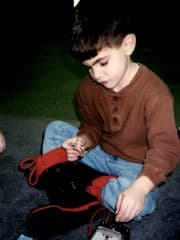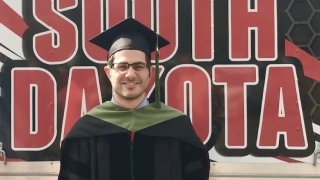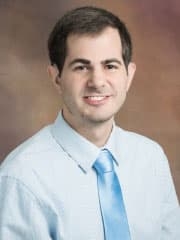Full Circle: The Patient Is Now an Audiologist
Published on
Published on
When audiologist Nick Arra, AuD, CCC-A, talks to children with hearing loss about touchy subjects — like how they may be embarrassed to use accommodations in school — he’s not just giving advice from a book. He’s speaking from experience.
Arra was a patient in the Center for Childhood Communication at Children’s Hospital of Philadelphia from when he was diagnosed with hearing loss at 2½ years until he was 18 years old.
“My mom tells me that when I was little, I initially resisted wearing hearing aids,” Arra says. “It was a new sensation, and I just kept removing them. The earliest I remember is wearing them in elementary school.” Later, he didn’t so much rebel as decline to take advantage of help and options that were available to him, especially in school.
 “I was a very stubborn kid, which influenced my decisions regarding hearing healthcare,” Arra says now. “I was given recommendations to optimize my listening environments, but I thought I only needed certain ones. I also wanted to blend in, not stand out from my peers.”
“I was a very stubborn kid, which influenced my decisions regarding hearing healthcare,” Arra says now. “I was given recommendations to optimize my listening environments, but I thought I only needed certain ones. I also wanted to blend in, not stand out from my peers.”
For example, his teachers could have worn a microphone in class, so he could hear better. But he refused the accommodation. “I thought I was compensating by sitting in the front of the room instead,” he says. “Looking back, if I had used the microphone, it would have been easier for me, less taxing. When you put more effort into listening, it causes listening fatigue.”
His Children's Hospital of Philadelphia (CHOP) audiologist during his teen years, Aruna Iyer, AuD, CCC-A, describes teenage Nick as a “sweet and well mannered” kid who was cooperative during appointments. But she also remembered he didn’t like change with regards to his hearing technology. For instance, Nick kept wearing his older technology hearing aid instead of a new, improved model.
“He also rejected wearing a hearing aid in his worse hearing ear as he felt like it didn’t help him understand speech,” Iyer remembers. “I explained to him that wearing both hearing aids would keep his nerve stimulated and open for other options, such as a cochlear implant. Nick was a teenager and continued to do what he thought was best.”
Because Arra worked extra hard to hear with his better ear and kept up good grades, his parents didn’t force him to wear both. In fact, he thrived in school.
“I was fortunate in that I had good friends and that no one bullied me,” he says. “I believed I was doing fine with my hearing because I was doing well in school.” Arra now says he might have performed even better academically if he had taken full advantage of classroom accommodations.
 In eighth grade, he went through a traumatic period when his hearing loss dropped significantly in his better ear. “I distinctly remember using the microwave and oddly not being able to hear the beeping sounds of the buttons, which I normally heard. I changed the battery of my hearing aid and I still couldn’t hear them. I went to school anyway, and realized late in the morning that I couldn’t sit in class anymore because I could barely hear my teachers,” Arra says.
In eighth grade, he went through a traumatic period when his hearing loss dropped significantly in his better ear. “I distinctly remember using the microwave and oddly not being able to hear the beeping sounds of the buttons, which I normally heard. I changed the battery of my hearing aid and I still couldn’t hear them. I went to school anyway, and realized late in the morning that I couldn’t sit in class anymore because I could barely hear my teachers,” Arra says.
His mother was able to schedule an appointment with Iyer later that day for a hearing test. Iyer confirmed a significant drop in his hearing. Within the following month, it continued to worsen to the point where his hearing aid no longer helped.
“A cochlear implant was recommended, but I wanted no part of it,” he says. A cochlear implant is an electronic device that – by taking over the function of the damaged hearing organ by stimulating the auditory nerve – can provide hearing via electrical stimulation. “I wasn’t convinced that my drop in residual hearing was permanent, so I waited it out, and it spontaneously recovered to its previous levels three months later,” Arra says.
It was during that incident that Nick was diagnosed with enlarged vestibular aqueduct (EVA) in both ears. EVA, a malformation of the inner ear that is present at birth, is one of the three most common causes of congenital hearing loss. Individuals with EVA are at risk for fluctuations or progression in hearing loss.
 Arra graduated from Methacton High School, aged out of CHOP and went to college at James Madison University, where he originally set his sights on becoming a physical therapist. Eventually, he began exploring audiology. That’s when he called his trusted audiologist, Iyer, seeking advice.
Arra graduated from Methacton High School, aged out of CHOP and went to college at James Madison University, where he originally set his sights on becoming a physical therapist. Eventually, he began exploring audiology. That’s when he called his trusted audiologist, Iyer, seeking advice.
They talked about the wide variety of career options within the field of audiology and discussed whether Nick would be able to manage certain aspects of audiology that required acute hearing, such as testing patients or conducting listening checks of equipment and hearing technology. “I was able to share with him that there were many clinical audiologists who have hearing loss and wear hearing aids or use cochlear implants,” Iyer says.
Nick changed his major to communication sciences and disorders, with the intent to pursue audiology, and spent a couple weeks in the summer of 2016 shadowing Iyer.
““It was a little weird when Nick was shadowing me, as he has always been a patient of mine, and now he was a student who was asking me very good questions,” Iyer says.”
At that time, Arra was wearing two hearing aids, having his college professors wear microphones and was considering a cochlear implant (CI) — all the advice he’d shunned before. “He’d come full circle,” Iyer says.
Arra attended graduate school at the University of South Dakota, as he was impressed by the faculty, curriculum and clinical rotations. With support from his cochlear implant professor and clinical supervisor, Jessica Messersmith, PhD, he underwent a cochlear implant surgery in his right ear in 2016. He earned his doctoral degree in audiology in 2018 following his clinical externship year at Yale-New Haven Children’s Hospital and the Yale Hearing and Balance Center.
Following graduation, he was working at his first job as an audiologist in Bethlehem, Pa., when Iyer got in touch with him. The Center for Childhood Communication had openings in audiology. Iyer knew that Arra’s dream was to work at CHOP from when he shadowed her. He started working at CHOP in May 2019.
The patient is now the clinician, splitting his time between CHOP’s Specialty Care Center in Bucks County and the Buerger Center for Advanced Pediatric Care.
Arra shares his own story with families when families ask. “I think it can be helpful for kids, and also for parents, to see an example of someone with hearing loss overcoming obstacles and achieving a dream just like any other person,” he says.
So, how does he handle it when one of his patients is less-than-compliant with following guidelines and accepting accommodations?
He takes the time to discuss and demonstrate equipment, like the classroom microphone system, during appointments so kids can better understand and appreciate how it will help.
“I emphasize that I made it harder on myself than it needed to be when I was younger, and that it took me a long time to overcome my self-consciousness,” Arra says. “As someone with hearing loss, what matters the most is not worrying about what other people may think about you, but setting yourself up for success.”